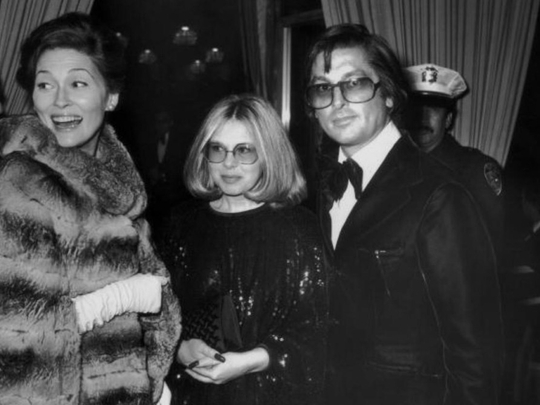
Can I Go Now?: The Life of Sue Mengers, Hollywood’s First Superagent
By Brian Kellow, Viking, 336 pages, $28
Biographer Brian Kellow, whose last subject was Pauline Kael, writes in “Can I Go Now?” that even he had doubts about whether Hollywood agent Sue Mengers would make a good subject. The idea of doing a book about her came from his agent. And even allowing for any prejudices an agent might have about how interesting agents are, it was still a stretch.
Mengers may have been the most glam, powerful, status-conscious, star-snuggling Hollywood power broker of the 1970s, but both she and her way of doing business had gone the way of the dinosaurs by the end of that decade. Now she is Sue Who? to the world at large.
Unlike Kael, who left a tremendous written legacy, Mengers (1932-2011) left no paper trail. She was known for deal-making, party-giving and wisecracking, and she brought her own special ruthlessness to all three. She also became exemplary for the hubris and lack of foresight that led her to divide the world into winners and losers — and that hit her hard once her early stable of winners (Ryan and Tatum O’Neal, Barbra Streisand, Dyan Cannon, Gene Hackman, Ali MacGraw, Candice Bergen, Peter Bogdanovich) either left her or stopped winning.
She had so little interest in building a deep bench of future talent that she asked the producer then nurturing “the young Martin Scorsese, fresh out of UCLA film school”: “Why do you spend all this time on these guys? Why not steal someone else’s client?” (Actually, Scorsese studied at New York University.)
So what did Kellow really have to work with? He says in his acknowledgments that he discovered what “Can I Go Now?” would be largely through the interviewing process. It turns out that an amazing number of the Hollywood players from the 1970s were still around to talk about Mengers’ cutthroat, baby-talking wiles.
Some of the people we hear from are Polly Bergen, Tuesday Weld, Trini Lopez, Sherry Lansing, Boaty Boatwright, Jerry Weintraub, Rona Barrett and Tina Sinatra, whom Mengers would tease about her stepmother, Barbara Marx: “One date. Give me one date with your father, and Barbara will be history.” Their stories give his book a supply of wild anecdotes, although the overall biography is too bleak to be fun.
This is a real failure on the author’s part, since anyone with a screen can see exactly how Mengers looked and sounded. He first mentions on Page 2, and repeatedly returns to, Mike Wallace’s 1975 “60 Minutes” piece on Mengers. She was enormously proud of it, with good reason.
It depicts a tricky, beguiling flirt who has Wallace just where she wants him, and whose power to coax others into doing her bidding is self-evident. This is a sly, glamorous blonde living in what she fully believed to be a man’s world, and making it spin to her own advantage. She couldn’t be less like the sometimes baby-talking, sometimes foul-mouthed climber whose allure never makes much sense in Kellow’s version.
“Can I Go Now?” — which takes its title from Mengers’ typically tender way of ending a phone conversation, and its subtitle, “The Life of Sue Mengers, Hollywood’s First Superagent”, from the misapprehension that there was no Lew Wasserman or Myron Selznick to precede her — is also poorly equipped to understand where her mix of gushiness and cruelty came from.
According to Kellow, her demanding mother (called “the Gorgon” by Mengers) and suicidal father, not to mention an early childhood in Hamburg, Germany, before the Nazi threat forced the family to emigrate to the United States in 1935, left Sue angry. And because of that anger, in Kellow’s version, “she was going to create the kind of life for herself that she wanted, and she was not about to apologise for the single-minded pursuit of it”.
Fine. But there are people from far worse backgrounds who don’t refuse to mingle with the non-famous, don’t make casually bigoted remarks and don’t wind up hating their clients. “I didn’t much like you anyway,” she told actress Beverly D’Angelo after their brief business relationship was over.
But the single most important and bizarre professional relationship Mengers had was with Barbra Streisand who, like so many key players in the Mengers story, was apparently ready and eager to talk about the past with Kellow.
Although one of Mengers’ occasional lapses in judgment led her to decide initially that Streisand was going nowhere, she quickly realised her mistake and began a long process of cultivation. She would ultimately become such a Streisand loyalist that when Faye Dunaway — a client Mengers didn’t like and didn’t keep long — won an Oscar for “Network” in 1977, Mengers’ response was “the only movie star in the whole town is Barbra Streisand.”
Mengers represented Elliott Gould, Streisand’s first husband, when he was at his most impossible; one of the book’s wildest stories comes from Kim Darby, John Wayne’s squeaky-clean co-star in the original “True Grit”, who saw an LSD-fuelled Gould put his foot through a glass coffee table on one occasion and show up wearing a football helmet, his face covered with cotton balls, on another. Darby, who had been called “the Doris Day of the Counterculture”, was afraid of Gould — and she didn’t stay with Mengers for long.
But Streisand did. Having parlayed her professional relationship with Gould into one with Streisand, Mengers milked the connection for everything it was worth — and more. The story of what went wrong is long, but it involves Mengers’ strange (and underexamined here) marriage to Belgian filmmaker Jean-Claude Tramont, her exploitation of her friendship with Streisand to help him and her shockingly ice-blooded response to Streisand’s objections.
When they had to part ways professionally, she flatly told Streisand, “I won’t be your friend if I can’t be your agent.” It’s not hard to see why, decades later, Streisand still finds this hard to reconcile with the adoring fan and “sister” Mengers once claimed to be.
That’s the trouble with this oddly flat biography of such a colourful character: it presents so many irreconcilable aspects of Mengers’ character and then does so little to meld them into an intelligible portrait. For every part of it that raises questions about what made her tick, there is something fatuous enough to make the reader want to give up hope, such as, “One of Sue’s favourite pastimes was reading each month’s issue of Vanity Fair.”
The paragraph continues with hosannas about the magazine, ending with Mengers telling its editor, Graydon Carter, that, “It’s like Proust.” Not coincidentally, Carter was a producer of “I’ll Eat You Last”, the 2013 one-woman show about Mengers that starred Bette Midler and opened a year and a half after Mengers died.
In the last years of her life she had a few loyal friends but had nearly vanished from public view: she smoked pot, watched television, ate and often refused to get out of bed. But posterity changes everything. It gives her a shot at the A-list again.
–New York Times News Service








